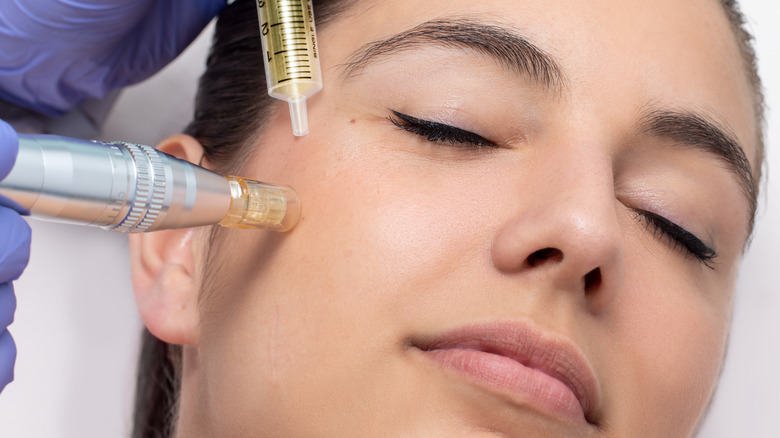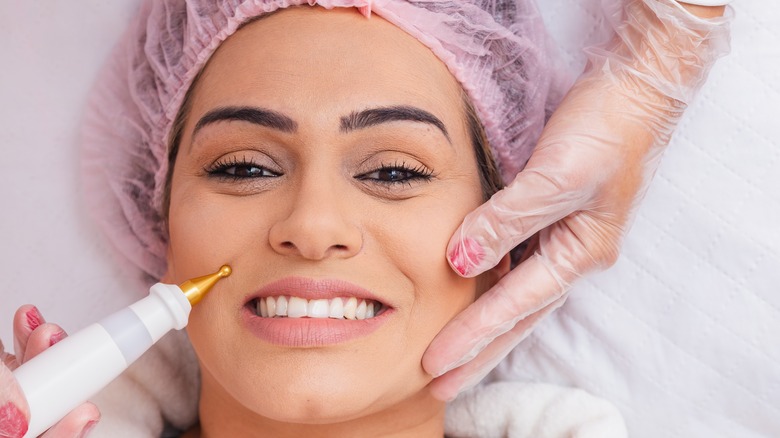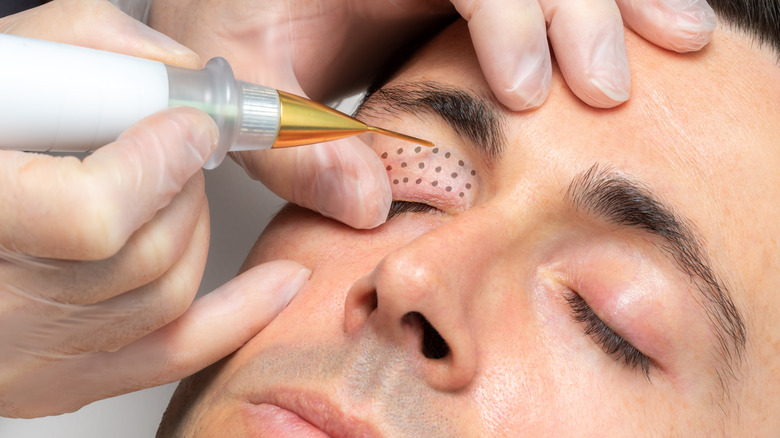Plasma Pens Are Celebrated As An Anti-Aging Innovation (But There Might Be Drawbacks)
If you've heard about the anti-aging tool called a plasma pen via TikTok or other social media, you might have been curious enough to look up what it's all about. When you do a Google search to learn what plasma pens are and how they work, the majority of results that pop up are med spas and other services that are actively selling sessions with a plasma pen. Some of the most common words used by these businesses to describe the service include "innovative," "advanced," and "new" (via Old Town Med Spa).
But how does a plasma pen actually work to rejuvenate skin? Does the treatment really live up to the hype? And are there any drawbacks?
The process of using a plasma pen is called fibroblasting. Fibroblasts are actually skin cells, and the pen causes minor trauma to these cells, which encourages them to produce more collagen, thereby increasing firmness, fullness, and elasticity of the skin (via Allure). In that sense, it works on a similar principle to microneedling. But rather than leaving teeny tiny punctures in the skin like microneedling, plasma pens actually create small burns to achieve a similar effect. The tool used for this procedure is called a plasma pen because plasma is what is created when a gas is super heated (it's called the fourth state of matter after liquid, solid, and gas). It's this super heated gas that is used to singe the skin.
The benefits
There are definitely good reasons that plasma pen treatments are going viral at the moment. Fibroblasting can not only treat skin aging like sagging, loss of firmness, and wrinkles; it can also be used to help with skin tags, stretch marks, and seborrheic keratoses (via Real Self). Further, it allows clients to focus on very small areas like lines near the lips, laugh lines near the eyes, and sagging eyelids. In all of these places, the treatment creates a transient appearance of firmer skin.
Professional sessions with a plasma pen also tend to be quite affordable compared to some other in-office anti-aging options, and the resulting collagen than is produced is fairly long-lasting, which means results can be expected to remain noticeable for up to three years. It generally only takes three sessions before you can take a years-long break while enjoying the results.
But before you pick up the phone to call a med spa for an appointment, there are drawbacks and risks you should take into consideration before making a decision to go ahead with plasma pen treatments.
The drawbacks
The first thing you should be aware of before making an appointment for a plasma pen treatment is that you will most likely experience some unsightly and uncomfortable side effects immediately following the treatment which can include peeling, bruising, scabbing, and swelling (via Real Self). Considering you are intentionally causing some trauma to your skin cells by burning them, this makes sense, but it's a good idea to plan to lay low for about a week if you don't particularly want to show up to a meeting or a date night looking like that.
If you are a person with olive or darker skin tones, you should be aware that plasma pen treatments may increase your chances of developing hyperpigmentation. And no matter your skin tone, plasma pens pose a risk of causing scarring or pitting (via Allure).
Further, while the short-term results of increased firmness of the skin might be desirable, burning or "cooking" the skin might have some undesirable effects in the longterm. As Dermatologist Dr. Devgan explained to Allure, "When you apply heat to tissue, you can tighten the tissue, but you're denaturing its proteins ... you want the smoothness, suppleness and movement of 'raw' or 'uncooked' tissue. And so that's the reason why applying heat or electrical or burning energy to the skin is not a desirable way to achieve tightening."


